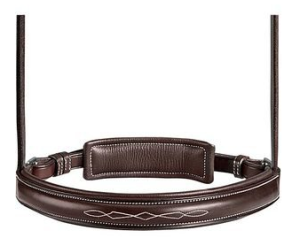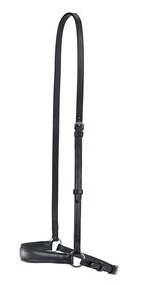 English bridles are composed of a variety of pieces, some of which are generally consistent, such as cheek pieces, and others that vary in appearance and purpose, such as nosebands. Nosebands are also known as cavesons and serve a few purposes. By keeping your horse’s mouth closed, nosebands encourage contact with the bit for better control, as well as reduce evasive behaviors in the horse, such as crossing his jaw or putting his tongue over the bit. Nosebands also can be used to attach a standing martingale and generally help keep the bridle in place. Learning the most common types of nosebands can help you make a selection for your horse.
English bridles are composed of a variety of pieces, some of which are generally consistent, such as cheek pieces, and others that vary in appearance and purpose, such as nosebands. Nosebands are also known as cavesons and serve a few purposes. By keeping your horse’s mouth closed, nosebands encourage contact with the bit for better control, as well as reduce evasive behaviors in the horse, such as crossing his jaw or putting his tongue over the bit. Nosebands also can be used to attach a standing martingale and generally help keep the bridle in place. Learning the most common types of nosebands can help you make a selection for your horse.
Types of Nosebands
- Plain Noseband– One band that
 sits about the width of two fingers below the horse’s cheekbone. Fastened with a simple buckle, this type of noseband is not expressly intended to hold the mouth closed, but can do so to a degree depending on how tightly it is adjusted. These are also sometimes called French or caveson nosebands and are popular in the hunter and equitation rings. Commonly used on horses that are quiet with their head and mouth while being ridden and do not typically exhibit bit-evading behaviors.
sits about the width of two fingers below the horse’s cheekbone. Fastened with a simple buckle, this type of noseband is not expressly intended to hold the mouth closed, but can do so to a degree depending on how tightly it is adjusted. These are also sometimes called French or caveson nosebands and are popular in the hunter and equitation rings. Commonly used on horses that are quiet with their head and mouth while being ridden and do not typically exhibit bit-evading behaviors.  Crank Noseband – Similar to a plain noseband, but fastened with a leveraged buckle for a precise, secure fit that will help hold the bit evenly in the mouth. Because this type allows the noseband to be fastened with a snug and evenly distributed pressure, padding is generally featured in the jaw area. Care should be taken to not tighten too much, as it will prevent relaxation in the horses’ face which is needed for proper contact with the bit. Crank nosebands are available in hunter and dressage styles.
Crank Noseband – Similar to a plain noseband, but fastened with a leveraged buckle for a precise, secure fit that will help hold the bit evenly in the mouth. Because this type allows the noseband to be fastened with a snug and evenly distributed pressure, padding is generally featured in the jaw area. Care should be taken to not tighten too much, as it will prevent relaxation in the horses’ face which is needed for proper contact with the bit. Crank nosebands are available in hunter and dressage styles.- Flash Noseband – Features a thin strap that
 is attached to the top center of a plain or crank noseband, drops at an angle to run in front of the bit and buckles in pace under the chin. These are designed to keep the horse’s mouth closed with the flash strap, while allowing a point of attachment for a standing martingale to the upper, caveson strap. Flash nosebands can come attached to a bridle with an existing tab, which is either stationary or removable, on a plain or crank noseband, or they can be purchased separately as an attachment.
is attached to the top center of a plain or crank noseband, drops at an angle to run in front of the bit and buckles in pace under the chin. These are designed to keep the horse’s mouth closed with the flash strap, while allowing a point of attachment for a standing martingale to the upper, caveson strap. Flash nosebands can come attached to a bridle with an existing tab, which is either stationary or removable, on a plain or crank noseband, or they can be purchased separately as an attachment.  Figure Eight Noseband – Upper straps are fastened under the horse’s jaw above the cheekbones, then cross the horse’s nose to the opposite side of his face and are fastened again with lower straps below his chin, in front of the bit. A round disk, lined with fleece or other padding, sits on the horse’s nose where the straps cross. When positioned correctly, high on the horse’s face, this type of noseband does not interfere with the horse’s breathing and does not push cheeks into teeth. There are two physical variations of this type of noseband; the ring style is fixed at the upper cheeks, while the slotted style allows for continuous tightening as leather slides through upper cheeks. Standing martingales should not be used with this type of noseband.
Figure Eight Noseband – Upper straps are fastened under the horse’s jaw above the cheekbones, then cross the horse’s nose to the opposite side of his face and are fastened again with lower straps below his chin, in front of the bit. A round disk, lined with fleece or other padding, sits on the horse’s nose where the straps cross. When positioned correctly, high on the horse’s face, this type of noseband does not interfere with the horse’s breathing and does not push cheeks into teeth. There are two physical variations of this type of noseband; the ring style is fixed at the upper cheeks, while the slotted style allows for continuous tightening as leather slides through upper cheeks. Standing martingales should not be used with this type of noseband.- Drop Noseband –
 One band which sits lower on the horse’s face than plain or crank nosebands. Fastened parallel to where it sits in front of the bit under the chin, similar to a flash, but still rests on the nasal bone. Will not push cheeks into the bit and holds the bit very steady in a horse’s mouth. This type of noseband should be used with a snaffle bit and cannot be used with a standing martingale.
One band which sits lower on the horse’s face than plain or crank nosebands. Fastened parallel to where it sits in front of the bit under the chin, similar to a flash, but still rests on the nasal bone. Will not push cheeks into the bit and holds the bit very steady in a horse’s mouth. This type of noseband should be used with a snaffle bit and cannot be used with a standing martingale.
As with all types of horse tack, the right type of noseband for your horse will depend on a variety of factors. All horses respond differently to pressure from different types of nosebands, so work with your trainer to determine what may be the best option to try. As for competing, rules regarding acceptable tack in competitions vary greatly by discipline and do change frequently. It is important to check with the governing body of any competitions you will be entering to determine what types of nosebands are permissible for your specific discipline. Finding the appropriate noseband for your horse should be about finding what he responds well to and what makes him happy and comfortable in his job.




can you add a bit to a hack bridle